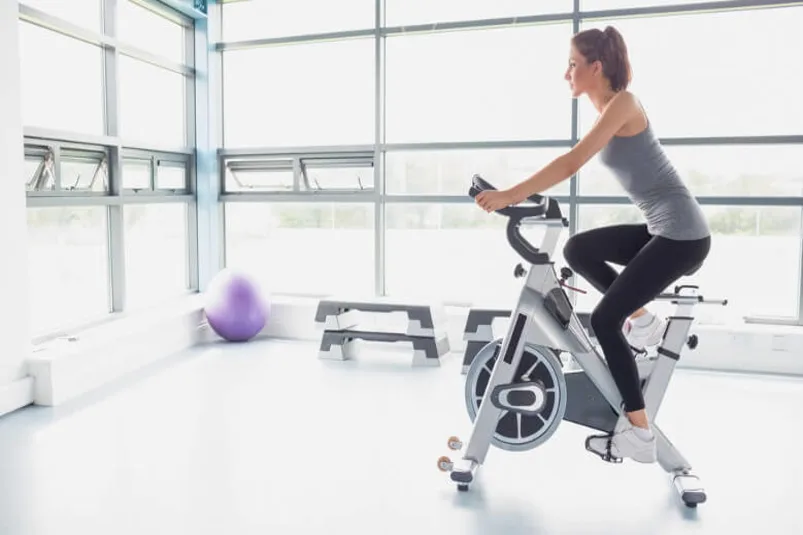Recumbent Bike vs Upright Exercise Bike: Which is Better?

Should I get an upright or a recumbent exercise bike? Which is better for weight loss? Which offers a better workout to tone glutes? What about the other muscle groups? Which is best for knee rehab? Is the recumbent bike better for back problems or back pain? To help you make the right choice, read our comparison and discover what are the differences between recumbent and upright exercise bikes.
1) Recumbent Bike vs Upright Bike for Weight Loss
The recumbent bike, also called the reclining bike, and the upright stationary bike both offer an efficient cardio workout to burn calories and fat. The main benefit of both cardio machines is that you can easily change your workout intensity by decreasing or increasing the bike's resistance and choose how many calories you want to burn.
Which burns more calories: the recumbent bike or the upright bike?
You will burn approximately 20% less calories on the recumbent bike than on the cardio exercise bike. The reason is simple: riding a recumbent bike is less demanding due to the sitting position so that it's harder to increase your heart rate as much as on the upright bike.
| 1 hour of training | Calories burned |
|---|---|
| Upright stationary bike, low to high intensity | 400 to 800 kcal |
| Recumbent bike, low to high intensity | 320 to 640 kcal |
As you can see in the comparison table above, the calories burned depend on how intense and how long you workout. You will burn for example about 640 kilocalories in one hour of intensive training on a recumbent bike and 800 on a stationary bike. But if you exercise at a low intensity, you will only burn 320 kilocalories on your recumbent bicycle in an hour.
Is the upright stationary bike better and more effective than the recumbent bike to lose weight?
The position on the recumbent bike is more comfortable and less demanding: you sit on it like on a normal chair, which reduces body fatigue and possible muscle soreness. If you want to burn the same amount of calories on your reclining bike, you will need to cycle longer. But as long as you workout in the aerobic zone, the zone in which your body burns fat to produce energy (60 % - 70% of your maximum heart rate), you will lose weight with either cardio machine. It is recommended to exercise for 30 minutes at least but you can cycle for 45 minutes, 1 hour or even 2 hours if you want to burn more fat.
But the stationary bike has another advantage over the recumbent bike. On the upright bike, you can do HIIT workout routines (high intensity interval training). HIIT is a cardio workout which alternates between intensive exercise phases (high intensity intervals) during which you cycle very fast or with a high resistance and recovery phases (low intensity intervals). This workout is extremely demanding and allows you to burn a lot of calories within a very short period of time (see How to lose weight on a stationary bike). Though it is theoretically possible to do a HIIT workout on a recumbent bike, it is not adapted to it.
If your main goal is to lose weight, then the stationary bike is probably a better option for you. You will burn more calories than on the recumbent bike and you can easily integrate prolonged cardio workouts of 1 hour or more in your workout plan as well as short HIIT workouts of 20 minutes.
How to lose 1 kg per month? Riding a stationary bike for 1 hour 3 times a week allows you to lose 1 kg per month. On the recumbent bike, you will need to workout 75 minutes 3 times a week for 1 month to get rid of 1 kilo.
2) Upright Stationary Bike vs Recumbent Bike: Which muscles are used?
Both cardio machines, the upright bike and the recumbent exercise bike, work out your most important muscle: the heart!
Both are cardio machines and not strength machines. Hence, they will help you to tone muscles and refine them but won't make them really inflate as body building or weight lifting would do.
They will both help you to strengthen your legs, your thighs and your buttocks muscles. This is very important if you want to lose weight because you want to tone your body at the same time.
What muscles does a recumbent bike work that an upright stationary bike also works?
The muscles targeted by the recumbent bike and the stationary bike are the muscles of the lower part of the body:
- The quadriceps and the hamstrings, muscles of the front and the back of the thigh, are constantly working while you are pedaling.
- The gluteal muscles (large, medium and small buttocks), also called glutes, are also working out when you are pushing the pedals.
- The calf muscles or calves, called triceps sural, located at the back of the leg, are used when you are cycling.
What muscles does a stationary bike work that a recumbent bike does not work?
On the recumbent bike, you are in a horizontal position or reclined position and the muscles of the upper body are not used. On the contrary, the upright stationary bike works the following muscles of the upper part of the body:
- The abdominal muscles or abs ensure the posture and the balance of the pelvis and the spine.
- The back muscles, the quadratus lumborum muscle and iliopsoas, help to maintain your position and support the spine.
- The biceps and triceps, the muscles at the front and back of the arms, are used when you to hold the handlebars. The arm muscles work more when you tighten the handlebars, especially in a sprint, or when you are riding out of the saddle with a high resistance.
When you are pedaling out of the saddle with high resistance, you put more pressure on your arm muscles (biceps and triceps) and on the muscles of the lower back while your thigh muscles (quadriceps) and your buttocks work less because you are using the weight of your whole body to cycle and thus your legs have less effort to provide.
The upright bike clearly targets more muscle groups than the recumbent bike
The advantage of the upright stationary bike over the recumbent bike is that it clearly targets more muscle groups. The upright bike also works the muscles of the arms, the back and the abs while the recumbent bike essentially works the muscles of the lower body. If your goal is to strengthen your legs or tone your glutes, then both bikes are suited.
WHAT YOU SHOULD KNOW. Increase the pedaling resistance of your exercise bike or your recumbent bike if you want to strengthen your legs and work your glutes. The higher the resistance, the more your muscles work. If the resistance is too low, you muscles will not work much and you won't see the results. By increasing the resistance, you will put more effort and also burn more calories!
3) Upright or Recumbent Bike for Knee Rehab or Back Pain?
Unlike the training on other fitness equipment like on the rowing machine, the movements on recumbent and exercise bikes are constant, smooth and safe for the joints.
The recumbent bike puts less strain on the knee than the upright bike, especially on the anterior cruciate ligament 1, due to the reclined position.The recumbent bike is thus very good for the knees and for rehab after an anterior cruciate ligament injury. For other knee problems or injuries, upright or recumbent bike are both suitable for knee rehab: there is a slight increase in the knee extension angle in the upright cycling position but not in the ankle angle between upright and recumbent position as suggested in this study 2. You should however always ask your doctor or your physician which exercise is adapted to you, at which intensity and which movements you should avoid.
The recumbent bike is also better for back pain, especially for lower back pain, than the upright bike. Thanks to its comfortable sitting position and its back support, the recumbent bike is better for people with lower back problems. On the upright bike, you need to make sure your saddle is at the right height and you keep a straight posture in order to avoid back pain (see how to have a good position on your exercise bike in our stationary bike workout advice).
The recumbent bike is generally speaking more suitable for seniors, elderly and people with back or knee problems than the upright bike.
WHAT YOU SHOULD KNOW. You should immediately stop cycling if you feel a pain in your knees, your back or any other part of your body. Always ask your doctor for advice before engaging in any kind of activity after an injury or an operation.
4) What are the pros and cons of the recumbent and upright exercise bikes in a nutshell?
The recumbent bike and the stationary bike offer great benefits for the heart and the cardiovascular system, help you improve your endurance and your fitness, lose weight, strengthen your legs and tone your glutes. But the two fitness machines correspond to different types of use which are summarized in the table below.
Comparative table of the advantages and disadvantages of each cardio machine:
Recumbent bike: pros and cons
• Easy to handle, various training possibilities
• Cardio training (not very demanding)
• Muscles legs, thighs and buttocks
• Energy expenditure: 320 to 640 kcal per hour
• Safe for the joints, good for lower back problems
• Suitable for beginners and seniors
Upright exercise bike: pros and cons
• Easy to handle, various training possibilities
• Cardio and Interval workout routines
• Muscle legs, thighs, buttocks, abs, arms and back
• Energy expenditure: 400 to 800 kcal per hour
• Safe for the joints
• Suitable for beginners, advanced and cyclists
The stationary bike, whether recumbent or upright, is suitable for almost any type of use, whether it is to stay in shape, for weight loss, rehabilitation, prevention or to tone up the muscles of the thighs, legs and buttocks.
The main difference is that the recumbent bike offers more comfort thanks to its seat and back support and offers a less intense workout. The recumbent bike will thus be better for seniors and people with knee problems or lower back problems.
The upright exercise bike is more demanding and will appeal to the people who want a more intense workout. It is better if you want to follow HIIT workout routines for example. It is also better if you want to get the same feeling as on your outdoor bicycle. Professional cyclists will prefer a spinning bike, a home trainer or a semi-professional stationary bike.
In any case, try to work out 30 to 45 minutes on your reclining or upright exercise bike 2 to 3 times a week. This is how you will get all the positive effects and benefits of the exercise bike on your body and your health!
References:
1. Knee loads in the standard and recumbent cycling positions. Reiser RF 2nd, Broker JP, Peterson ML. Biomed Sci Instrum. 2004;40:36-42.
2. Influence of Hip Orientation on Wingate Power Output and Cycling Technique. Raoul F Reiser, Michael Peterson, Jeffrey P Broker. The Journal of Strength and Conditioning Research 16(4):556-60 · December 2002.

Clara Miller
Fitness Writer
Clara Miller has a Master's degree in Sports Science and has worked for famous sports and fitness brands. She is passionate about sports and regularly writes about fitness, weight loss and motivation for various blogs and magazines.
